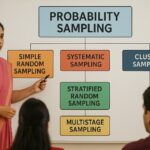If you’ve ever wondered how businesses predict sales, how economists forecast trends, or how analysts estimate relationships between variables. Regression Analysis is often the magic behind the scenes.
In this blog post, we’ll break down the concept of Regression Analysis, explore Simple and Multiple Regression, and illustrate each with practical, real-life examples. Whether you’re a student, data enthusiast, or a working professional, this guide will make the idea of regression less threatening and more intuitive.
What is Regression Analysis?
Regression analysis is a powerful statistical technique used to understand the relationship between one dependent variable (the outcome) and one or more independent variables (the predictors). The goal is to model this relationship so we can predict, analyse, and interpret data effectively.
Think of it as drawing the best-fit line through a cloud of data points that tells you how changes in the inputs (independent variables) are likely to affect the output (dependent variable).
These applications of regression analysis are crucial because they empower better decision-making by revealing which factors have the most significant impact on outcomes. By predicting future trends or behaviours, regression models help businesses and institutions reduce risk and manage uncertainty more effectively. Additionally, understanding the drivers of performance allows organizations to allocate resources strategically and optimize their efforts for improved efficiency and results.
Why Use Regression Analysis?
Prediction: Forecast future outcomes like sales, prices, or performance.
Trend Analysis: Understand how variables change over time.
Decision Support: Help businesses make data-driven decisions.
Risk Management: Identify factors that impact success or failure.
Tips for Performing Regression
Visualize your data: Always start with a scatterplot to detect patterns.
Check assumptions: Linearity, independence, normality, and equal variance.
Watch out for outliers: They can skew your results.
Interpret with context: Regression gives estimates, not certainties.
MAJOR TYPES OF REGRESSION ANALYSIS
1. Simple Linear Regression
Simple linear regression examines the relationship between one independent variable and one dependent variable by fitting a straight line (linear equation) to the data.
The formula looks like:
Y = a + bX + ε
Where:
Y = Dependent variable (what you’re trying to predict)
X = Independent variable (predictor)
a = Intercept (value of Y when X = 0)
b = Slope (change in Y for each unit change in X)
ε = Error term
Explanation of the Equation
The equation Y = a + bX + ε is the basic form of a simple linear regression model, which is used to describe the relationship between two variables—one dependent and one independent.
Here’s what each component means:
Y (Dependent variable):
This is the outcome or result you’re trying to predict or explain. For example, it could be sales, exam scores, or house prices.
X (Independent variable):
This is the input or predictor variable that influences Y. For instance, advertising spend, study hours, or house size.
a (Intercept):
This is the value of Y when X is 0. It represents the baseline or starting point of the dependent variable.
b (Slope):
This shows how much Y changes for a one-unit change in X. A positive slope means Y increases as X increases; a negative slope means Y decreases as X increases.
ε (Error term):
This accounts for the variation in Y that can’t be explained by X. It captures all other unknown factors or randomness affecting the outcome.
Together, this equation helps us estimate and understand how changes in the predictor (X) impact the outcome (Y), while acknowledging that not everything can be perfectly predicted.
Example 1: Retail Sales Prediction
Scenario: A store wants to predict monthly sales (Y) based on advertising spend (X).
Regression Model:
Sales = 2000 + 3 × Advertising + ε
Explanation:
Y (Sales) is the amount the store expects to earn.
X (Advertising) is the amount spent on advertising.
a (2000) is the baseline sales even with no advertising.
b (3) means for every extra Rupee spent on ads, sales increase by Rs.3.
ε represents other factors affecting sales (seasonality, market trends, etc.).
Example 2: Education Performance
Scenario: A teacher wants to estimate exam scores (Y) based on study hours (X).
Regression Model:
Exam Score = 50 + 5 × Study Hours + ε
Explanation:
Y (Exam Score) is the predicted test score.
X (Study Hours) is how long a student studies.
a (50) is the expected score with zero study hours.
b (5) means each extra hour of study raises the score by 5 points.
ε includes other influences like prior knowledge or sleep.
Example 3: Employee Productivity
Scenario: A company studies the effect of training hours (X) on employee productivity (Y).
Regression Model:
Productivity Score = 60 + 2 × Training Hours + ε
Explanation:
Y (Productivity Score) is what they aim to improve.
X (Training Hours) is the variable under the company’s control.
a (60) shows the initial productivity score without training.
b (2) means each hour of training improves productivity by 2 points.
ε could account for experience, motivation, or environment.
Applications of Simple Linear Regression
1. Marketing & Sales
Marketers use simple regression to understand how one factor affects sales (Dependent Variable). For example:
- How does increasing ad spend impact revenue?
- What is the effect of price on product demand?
This helps in setting budgets and optimizing campaigns.
2. Education
Educators and researchers often use it to see how one variable like study time affects exam performance (Dependent Variable). This can help design better learning strategies or predict student outcomes.
3. Health & Fitness
Fitness apps may use regression to estimate calories burned (Dependent Variable) based on a single factor like exercise duration. This helps in setting fitness goals for users.
2. Multiple Linear Regression
Multiple linear regression extends the concept by using two or more independent variables to predict the dependent variable. Multiple linear regression helps us to understand which factors significantly influence the outcome and estimate the combined effect of several variables on a result and also make predictions when multiple inputs are available.
The formula:
Y = a + b₁X₁ + b₂X₂ + … + bₙXₙ + ε
Explanation of the Equation
Y (Dependent Variable):
This is the outcome you’re trying to predict or explain.
Example: House price, customer satisfaction, or sales revenue.
X₁, X₂, …, Xₙ (Independent Variables):
These are the predictor variables—factors that influence or are believed to affect Y.
Example: For predicting house price, the predictors might be house size (X₁), location score (X₂), and number of bathrooms (X₃).
a (Intercept):
This is the predicted value of Y when all X variables are zero. It serves as the baseline or starting value.
b₁, b₂, …, bₙ (Regression Coefficients):
Each coefficient (b) shows how much Y changes with a one-unit increase in the corresponding X variable, assuming all other variables remain constant.
b₁ tells the effect of X₁ on Y
b₂ tells the effect of X₂ on Y, and so on.
ε (Error Term):
This captures the variation in Y that can’t be explained by the model—randomness or other hidden factors not included in X₁ to Xₙ.
Practical Example
Scenario: A company wants to predict employee performance (Y) based on:
Years of experience (X₁)
Training hours (X₂)
Workplace satisfaction score (X₃)
Model:
Performance = a + b₁ (Experience) + b₂ (Training Hours) + b₃ (Satisfaction Score) + ε
This model allows the company to understand:
- How much each factor contributes to performance?
- Which areas (like training or workplace culture) to improve?
- What combination of factors leads to high-performing employees?
Applications of Multiple Linear Regression
1. Real Estate
In real estate, multiple regression is commonly used to estimate House Prices (Dependent Variable) based on various factors (Independent Variables) such as:
- Location
- Size of the property
- Number of bedrooms
- Proximity to schools or public transport
This helps realtors, investors, and buyers make informed pricing decisions.
2. E-commerce
Online retailers use it to predict a Customer’s Purchase Amount (Dependent Variable) based on factors (Independent Variables) like:
- Time spent on the website
- Number of items viewed
- Use of discount codes
This guides personalized marketing and improves the shopping experience.
3. Healthcare
Hospitals and healthcare researchers apply it to predict Patient Recovery Time (Dependent Variable) by analysing (Independent Variables):
- Age
- Type of treatment
- Lifestyle habits (like physical activity or diet)
Such insights help improve patient care and allocate resources more effectively.
4. Finance & Banking
Financial analysts use it to estimate credit risk or loan default probability (Dependent Variable) by evaluating multiple factors (Independent Variables) such as:
- Income level
- Employment history
- Credit score
Banks use these models for smarter lending decisions.
Final Thoughts
Regression analysis is a cornerstone of statistical analysis and data science. It simplifies complex relationships into understandable numbers and models that help us make sense of the world. Whether you’re predicting sales, estimating real estate values, or analysing customer behaviour, understanding simple and multiple regression can be a game-changer.
Unlock the power of regression analysis to make smarter, data-driven decisions. Start applying it today to uncover hidden insights and drive impactful outcomes! Contact for Assistance to conduct Regression Analysis for your Research.









Leave a Reply